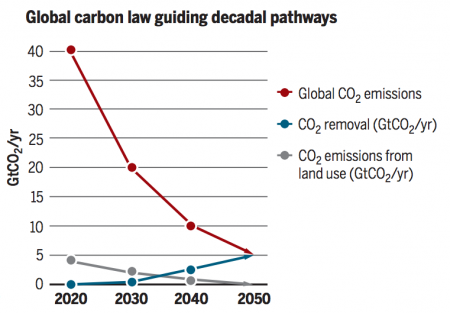April 3, 2017 – The world faces a daunting task over the next three decades taking us to 2050. By that date, if we are to stop the relentless climb in global temperatures caused by human-generated greenhouse gasses, we need to be at net zero. And we have to do this while ensuring the economies of the Developed World don’t crash and burn, and those of the Developing World still grow to raise the quality of life for the billions who live in them.
A roadmap to achieve net zero has recently been published in Science, the journal of the American Association for the Advancement of Science. Authored by researchers from Stockholm University, The Royal Swedish Academy of Sciences, the International Institute for Applied Systems Analysis, ETH Zurich, the Potsdam Institute for Climate Impact Research, and University of Melbourne, it describes what needs to happen globally:
- For every decade between now and 2050, carbon dioxide (CO2) emissions from industry and energy must be halved. That means a drop by half of the total in the 2020s, and then a drop by half again in the 2030s, and so on.
- Land use emissions from forestry and agriculture have to be reduced to net zero by 2050.
- Carbon capture and sequestration technologies need to be deployed globally to reach a goal of artificially sucking out 5 gigatons of CO2 annually from the atmosphere, double the amount of natural land-based sequestration from soil and trees.
The line graph displayed below provides a visual reference to these three objectives.

These three objectives are seen as consistent with a 75% probability of limiting warming to below 2 Celsius (3.6 Fahrenheit) degrees, and a 50% probability of limiting warming to below 1.5 Celsius (2.4 Fahrenheit) degrees by 2100. If humanity can achieve these results then CO2 levels in the atmosphere will drop by century end to 380 parts per million.
The researchers have looked to Moore’s Law for inspiration, inspired by Gordon Moore, a co-founder of Intel, who predicted that the number of transistors per square inch on integrated circuits would double every two years. Moore’s Law has continued to apply 50 years after his first speculation. When applied to climate and carbon emissions, the researchers chose decades and not years as units with a reduction formula of 50%. And they didn’t draw up the formula purely on speculation. They looked at the trajectory of the current decade where we have witnessed a flattening in human CO2 emissions over the last three years largely from the reduction in the burning of coal and came up with the following milestones.
2017-2020
Universal application of carbon taxes and other market solutions such as cap-and-trade, feed-in tariffs, and quotas will put a break on annual emissions. The floor price for CO2 should be $50 U.S. per ton and be rising above that amount after 2020. Fossil-fuel subsidies of $500-600 billion annually would have to end by 2020. Currently, the target set by G7 nations is to end fossil-fuel subsidies by 2025. All cities and corporations in the Developed World will have in place comprehensive decarbonization strategies. More than 100 countries (up from 49 today) will have established carbon neutral by 2050 programs. Developed nations will provide financial and consultative help to Developing World nations to help them grow using low-carbon development strategies. And agribusiness and farms, plus food distribution providers will implement sustainable practices that remove carbon, reduce food waste, and alter diet choices globally.
2020-2030
Global improvements in energy efficiency should reduce emissions by 40-50% over the decade. Carbon pricing will rise from $50 to $200 per ton. Coal will almost be eliminated. Internal combustion and diesel engines will be phased out so that all new cars from 2030 onward will be fully decarbonized. Renewable fuels and electrification will be the primary energy source for land and air transportation. Natural carbon sinks will be expanded with initiatives to expand forests. Investments in CCS will be realized in this decade through global deployment of sequestration in existing fossil-fuel facilities, and deployment of direct-air CCS to achieve up to 500 Megatons of CO2 removed annually.
2030-2040
A number of Developed Nations will be 100% electrified by 2040. Carbon pricing will rise to $300 per ton. The internal combustion engine will be a rare site on roads. Air transport will run on biofuels and hydrogen. Construction materials and buildings erected in this decade will be either carbon-neutral or carbon-negative using emissions-free concrete and steel, and negative-emission materials such as wood, stone and carbon fiber. CCS capacity to remove CO2 will grow to 2 Gigatons per year by the end of the decade. Global energy generation and distribution will encompass the Developing World through new methods of delivery. Financial instruments and government reforms will foster investment in transformative and sustainable technologies while penalizing wealth generated from carbon emitting sources.
2040-2050
Trial and error will winnow out technologies and policies that don’t achieve targets. The Developed World nations will be net-zero early on in the decade with the rest of the world following by 2050. Natural gas with CCS technology will continue to be used but largely for backup to a world running entirely on renewable energy sources. Modular nuclear power stations and fusion reactors, dissimilar to those we use today will contribute to the energy mix. Agriculture will be net zero. And CCS technology deployment globally will draw down over 5 Gigatons of CO2 annually.
The researchers note that “disruptive progress” of this type will require a revisit and refinement every two years to ensure that decadal targets are met. They write, “although signs are positive that the world is on track to rapidly transform to a net-zero–emissions global economy, contagion dynamics cut both ways. If political signals do not support a rapid transition, for example, by a failure to implement worldwide financial and regulatory reform that places a cost on carbon, then it is difficult to imagine keeping warming at well below 2 Celsius.” They also advise that in global governance, “climate stabilization…be placed on par with economic development, human rights, democracy, and peace.”
I have stated before that only a Manhattan Project mindset by world governments can meet the climate crisis in this century. The political will backed by global citizenry is needed to achieve net-zero. There are very few politicians prepared to talk about this on these terms. Maybe that’s why federal scientists in the United States are recommending considering tinkering with the atmosphere using geoengineering technologies to see if reducing solar radiation rather than tackling carbon emissions can help to manage climate change.



















